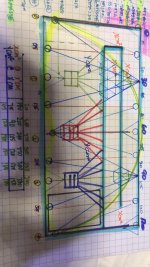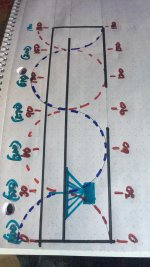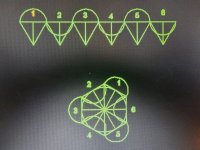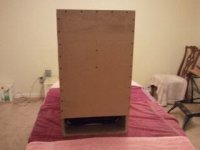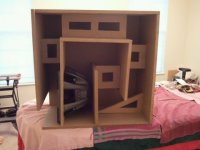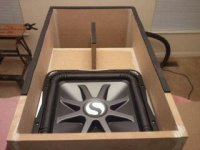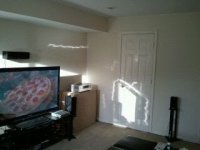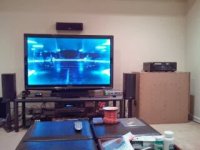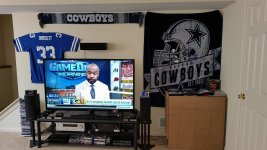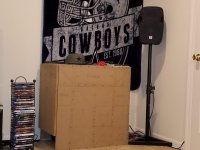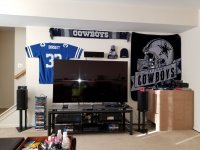Kaffi and Klipmam,
what BR designs with what drivers you think will be good to add to the pool of options,
from there we will select 2 or 3 that will get the most bang for the buck
the market is very volatil and with this inflation and recession im gravitating toward budget options.
what BR designs with what drivers you think will be good to add to the pool of options,
from there we will select 2 or 3 that will get the most bang for the buck
the market is very volatil and with this inflation and recession im gravitating toward budget options.
Noted.This box on databass illustrates port compression quite well (even though it has a relatively large port)
Not sure if they even sell this thing anymore, the Ridge Audio GUJ18V1 has an fs of 19.9Hz, qts of about 0.41 and claims 30mm worth of xmax, the driver is being pumped with up towards 183 volts in the review. Also claiming they went over the 30mm xmax some times.
As far as I can tell, it's a slightly undersized box combined with a woefully inadequate port, these are the most common reasons why I get myself worked up over these things.
It does not help that you take a box that might work well for one driver and decide to throw in some 30mm xmax monstrosity in it for giggles, these things have to be considered carefully before making sawdust, as we all probably know.
I was starting on a long winded reply here but it serves no purpose, the resonance shows up just fine in Hornresp.
Edit:
If anyone else chimes in with a value for money option you might get 2 total.pool of options
The Dayton 460-8 can probably be used in double BR boxes, just have to look at the numbers, it is 170$ each and you need 2. Not huge xmax but you will get decent bang per buck.
Are there any other shops than Parts Express you want me to look at?
Edit2:
The Dayton Odeum Apollo 18F might work well, they are 250$ each.
Last edited:
I don't have a specific box design but the B&C 18TBX100 is great value and Gisen K21x4 is also good value. As for designing a port you should read this paper: https://www.diyaudio.com/community/...potential-own-vibrations.391145/#post-7147379
An excellent read.
My "high-ish output" speakers use Aero ports that are very correctly dimensioned, just in case I would be able to afford some more expensive drivers in the future.
Been looking at parts express a bit, you mentioned single driver subs, and the best 18" might be a 21"!
Tha Dayton PSS555-8 looks very nice!
My "high-ish output" speakers use Aero ports that are very correctly dimensioned, just in case I would be able to afford some more expensive drivers in the future.
Been looking at parts express a bit, you mentioned single driver subs, and the best 18" might be a 21"!
Tha Dayton PSS555-8 looks very nice!
That's all well and good, but you also mentioned wanting smaller single 18" boxes that you can move yourself.the market is very volatil and with this inflation and recession im gravitating toward budget options.
So we need to know what kind of size you are talking about, something like 180-220 liters?
The gisen looks more like the internals of a XLS2500 but doubled for 4 channelsI don't have a specific box design but the B&C 18TBX100 is great value and Gisen K21x4 is also good value. As for designing a port you should read this paper: https://www.diyaudio.com/community/...potential-own-vibrations.391145/#post-7147379
Look how the Sanway look inside (they shadowed the Po..So... design )
kind of what Behringer did with QSC with the RMX series long time a go
this is the internals of the 1U rack mount 4 ch amp from Sanway
KaffiMann,Just a quick recap of the dirt-cheap double Thomann driver vs the Keystone using a quite expensive single 18":
View attachment 1101594
To be fair, the difference varies between nil to just under 6dB, I bet that 80-100Hz boost is the main reason you feel it has "significantly more output", I'll play nice and pretend like thermal and power compression does not exist for a small moment, and if we just roughly average out the difference it's around 3db.
How much power did you use again? 1700W? And the other one is using max 800W?
So the difference in power is roughly about 3dB, and the difference in SPL is roughly about 3dB.
You cannot possibly claim that the Keystone 18" has a 6dB advantage against similarly sized double 18" BR boxes.
It. Just. Does. Not. Add. up.
Now... If we do add problems like thermal and power compression I am willing to bet hard earned cash that the difference between the Keystone running@1700W/driver vs the cheap double Thomann 18" BR would be negligible at best, except the indisputable fact that the cheap design needs smaller amplifiers as well.
I completely agree that an amplifier that can deliver 100 volts without current limiting at 2 ohms will cost more than one that delivers 50volts at 4 ohms, and that drivers with twice the performance capability will probably cost at least twice as much.
My claim has not been that a single 18” Keystone would be louder than a double driver BR using B&C18SW115-4, just that it requires the same voltage and a single driver to achieve approximately the same level as the 2x18” BR of the same volume. This is an actual outdoor measurement of the raw response of the Keystone and a single 18" BR:
The BR is quite flat- pretty much optimized, a bit more bottom, a bit less top.
Here is what Hornresp shows using a 340 Liter dual 18" BR compared to the 340 Liter Keystone:
As you have shown in post #18, the B&C 18SW115 has nearly double the excursion (and displacement) of the Thomann 18-500/8A, by whatever mechanical derivation of Xmax you choose.
B&C also includes “Xvar” in their specifications, the excursion when the magnetic field seen by the voice coil, or the total suspension compliance, or both, drops to less than 50% of their small signal value, producing high distortion levels, strong variations from small signal behavior and power compression.
I have usually used 15mm for simulations with the B&C 18SW115, between the Xmax of 14 and the Xvar of 16, as it performs with low distortion to 15mm.
Your simulation is not showing the output potential of the Keystone using the 97volts required for 15mm excursion, you can see in the above it has >134dB potential 40Hz and up, compared to 128dB for the Thomann 18-500/8A.
A six dB increase is equivalent to achieving the same level at twice the distance, or using half the boxes to achieve the same level.
Art
The dayton 21 looks very nice, what would be the gain of performance between the dayton 21" vs the B&C 18TBX100 18" driver, i do not mind going 21" in single driver cabinets as long there is more benefits than the 18TBX100, now another thing that i do not know, how is the difference of using the same driver on a dual BR enclosure than using 2 single BR boxes ( using the same driver ) i am asking cause i see designs that internally they do not separate the chamber in 2, the 2 drivers share the same chamber, does that do a gain in Db's or is the same using 2 discreet single driver boxes.That's all well and good, but you also mentioned wanting smaller single 18" boxes that you can move yourself.
So we need to know what kind of size you are talking about, something like 180-220 liters?
If single i think i can go to a size that can best use the dayton 21", is the yorkville ES18P a scoop design ? altough it looks like BR, seems to have a horn in the back with the vent on the bottom , i seen hybrid designs so idk , the LS1208 (yorkville) have much acceptation here in my town but i think that is a TH if ai m nit mistaken, and on the yorkville website they said the Mr. Danley design it for them , according to their website "A two year investigation into the optimization of high output low frequency sound has yielded the LS1208 "basspipe" subwoofer system. The "basspipe" is a multiple flare horn, connected to an organ like pipe, slowly flaring to the mouth. The bandwidth is narrowed, optimized to a specific range in the lower registers"
anyway, if getting the dayton, what box will squezze the most of the driver.
maybe redeign these higher order boxes with smoother/flatter respones instead of so rollercoaster and undamped looking or whatevef the case? we can look at this anytime thanks to mr Mcbeans diligence and never ending ways to allow us to discover what others dont see if they arent trying to argue a point instead(arguing is extremely useful too of course)I'm not trying to wade in on whether BR or TH are better to me it depends on situation. I'm trying to make the point that Hornresp simulations are of limited use in directly comparing two boxes of similar predicted output capability. This box on databass illustrates port compression quite well (even though it has a relatively large port): https://data-bass.com/#/systems/5c2d2600d3a6a500040a808c?_k=w2d1gu
there is also some compression due to high excursion in the 40-60Hz range.
I have also compared a low end and a mid range driver in a bass reflex design and found while at some frequencies in the pass band the mid range driver offered +6dB more output at other frequencies maximum output was negligible: https://www.diyaudio.com/community/threads/isobaric-sub-based-on-pyle-plpw15d.345807/#post-7039398
?
green red or blue positions, CSA?TS parameters... sized .. this is so very very intersting in 'parallel' versions, more and more!
Attachments
Last edited:
smoooth.....maybe redeign these higher order boxes with smoother/flatter respones instead of so rollercoaster and undamped looking or whatevef the case? we can look at this anytime thanks to mr Mcbeans diligence and never ending ways to allow us to discover what others dont see if they arent trying to argue a point instead(arguing is extremely useful too of course)
?
green red or blue positions, CSA?TS parameters... sized .. this is so very very intersting in 'parallel' versions, more and more!
Attachments
And that is excellent performance for a single driver!it requires the same voltage and a single driver to achieve approximately the same level as the 2x18” BR of the same volume.
I just wanted to make sure that all the facts are on the table, some of the information implied in your threads just seemed highly improbable. And I did not want to intrude on your space, this is a double BR versus TH thread so I feel less opposed to voicing a few concerns.
It seems to me that when you cross over the 130dB threshold you just need an ridiculous amount of either power and/or amount of speakers to make much of a difference.
Up to 130dB is not too bad, but crossing 140?
Very tough.
And is it worth the effort (aiming for 140)? I do not think so.
I'm not near a computer at the moment, but the 21" could possibly go around 7Hz lower approximately at a similar spl, just a quick approximation by sticking my index finger in the air and judging the wind direction. Dual boxes would be a bit heavy.what would be the gain of performance between the dayton 21" vs the B&C 18TBX100 18" driver
Last edited:
And that is excellent performance for a single driver!
I just wanted to make sure that all the facts are on the table, some of the information implied in your threads just seemed highly improbable. And I did not want to intrude on your space, this is a double BR versus TH thread so I feel less opposed to voicing a few concerns.
It seems to me that when you cross over the 130dB threshold you just need an ridiculous amount of either power and/or amount of speakers to make much of a difference.
Up to 130dB is not too bad, but crossing 140?
Very tough.
And is it worth the effort (aiming for 140)? I do not think so.
LOL!! so single 21's boxes.... what plans...i do not want to reinvent the wheel, some tried and effective plans will be welcomed!!! 🍻🍻🍻, just a quick approximation by sticking my index finger in the air and judging the wind direction. Dual boxes would be a bit heavy.
Here's a single 21" design: https://data-bass.ipbhost.com/topic/868-riccis-ckram-subwoofer-and-files/
Double 18s are mostly for convenience if you have a load in where you don't go up stairs etc. and a reduction in weight compared to two single 18s. The single 18s have an easier time with port design.
Double 18s are mostly for convenience if you have a load in where you don't go up stairs etc. and a reduction in weight compared to two single 18s. The single 18s have an easier time with port design.
Thanks Kipman,the specs of the Ricci design are impressive , it is like 3db more efficent at spl than the suggested lavoce enclosure and i think smaller. budget driver for it is the lavoce, around 660 each.Here's a single 21" design: https://data-bass.ipbhost.com/topic/868-riccis-ckram-subwoofer-and-files/
Double 18s are mostly for convenience if you have a load in where you don't go up stairs etc. and a reduction in weight compared to two single 18s. The single 18s have an easier time with port design.
Hello Maxolini,
Ricci has also the Skram project using 21" and I make the plan available here https://freeloudspeakerplan.rf.gd/ but you adjust the model to use 18" or 15".
Sometime, deciding what loundspeaker to build is a headache. My suggestion for you would be:
In general each person have a different constrain for a decision, but one of the constrains are more important (dominant) them the others, in my case for a small system I'm limited for a single amplifier for a subwoofer, so what design gives you more output acoustical power in this condition?
find your predominant constrain, it will lead you to a better decision.
Is AC power supply your limitation?
The box must be carried for a single person?
Are you space constrained? the box must be moved inside a van or other?
Are you OK to get more output using more boxes? so no amplifier constrain once more boxes means lower impedance
What is the limit of your amplifier?
Are you constrained buy costs? Cheap is better? try to evaluate how much output dB you achieve / euro or dollar.
let me say
100V applied to two TH using drivers X (8ohm parallel to 8ohm = 4 ohm) will delivery how many dB?
100V applied to two BR using the same drivers X (8ohm parallel to 8ohm = 4 ohm) will delivery how many dB?
Do not play too much in theory side of things, also check your real-world constrain it will lead you to a better decision.
Ricci has also the Skram project using 21" and I make the plan available here https://freeloudspeakerplan.rf.gd/ but you adjust the model to use 18" or 15".
Sometime, deciding what loundspeaker to build is a headache. My suggestion for you would be:
In general each person have a different constrain for a decision, but one of the constrains are more important (dominant) them the others, in my case for a small system I'm limited for a single amplifier for a subwoofer, so what design gives you more output acoustical power in this condition?
find your predominant constrain, it will lead you to a better decision.
Is AC power supply your limitation?
The box must be carried for a single person?
Are you space constrained? the box must be moved inside a van or other?
Are you OK to get more output using more boxes? so no amplifier constrain once more boxes means lower impedance
What is the limit of your amplifier?
Are you constrained buy costs? Cheap is better? try to evaluate how much output dB you achieve / euro or dollar.
let me say
100V applied to two TH using drivers X (8ohm parallel to 8ohm = 4 ohm) will delivery how many dB?
100V applied to two BR using the same drivers X (8ohm parallel to 8ohm = 4 ohm) will delivery how many dB?
Do not play too much in theory side of things, also check your real-world constrain it will lead you to a better decision.
With drivers like the B&C 115mm series quite capable of handling 6400 watt peaks (160volts), peak output exceeding 140 dB at one meter certainly is possible from single 18" TH or dual 18" BR in the upper sub range. Using 21" can get there down low too.And that is excellent performance for a single driver!
I just wanted to make sure that all the facts are on the table, some of the information implied in your threads just seemed highly improbable. And I did not want to intrude on your space, this is a double BR versus TH thread so I feel less opposed to voicing a few concerns.
It seems to me that when you cross over the 130dB threshold you just need an ridiculous amount of either power and/or amount of speakers to make much of a difference.
Up to 130dB is not too bad, but crossing 140?
Very tough.
And is it worth the effort (aiming for 140)? I do not think so.
There is little more effort to build cabinets for higher power/excursion drivers.
Building, transporting and storing half of them compared to using drivers with around half the capability seems like less effort to me.
Having built and compared a wide variety of cabinets with various drivers since the 1970s, it has been interesting to participate as the power and excursion capabilities of the better professional level 15" or 18" ramped up from 100w/2mm, 200w/4mm, 600w/6-8mm, now reaching around 1700w/16mm.
Each change brought an increase of 6dB in the low end, like doubling the amount of cabinets, surprising clients when they would see a smaller system that would kick way harder than the one they last used.
Each brought quite a jump in cost, but was always worth it, even in those days when the cost for displacement and power was more than double what it is now.
Art
Last edited:
In it's simplest form, a TH requires only 7 pieces of wood just like a BR enclosure. In that situation, the difficulty in builds are null in void.
Also in that form, you can change the design characteristics.
Positive flare = TH, big enclosure, high SPL.
Straight flare = TQWP or TQWT, easy build, no angles.
Negative flare = T-TQWT or T-TQWP, small enclosure, low tune, still more efficient than a BR enclosure.
Positive flare = TH, big enclosure, high SPL.
Straight flare = TQWP or TQWT, easy build, no angles.
Negative flare = T-TQWT or T-TQWP, small enclosure, low tune, still more efficient than a BR enclosure.
My home theater sub is a Tapped-Tapered Quarter Wave Tube/Pipe. I chose small and low... Hofmann's Law...loud, low, small...pick 2. Even though I chose the least efficient TH, I was still able to crack multiple walls with less than 200 watts of old AVR power.
Attachments
The enclosure was built in 2012 and finally painted this past summer.
Attachments
- Home
- Loudspeakers
- Subwoofers
- Dilema on what route to take double 18s reflex or TH
